Working on cruise ships is hard, demanding and sometimes very tiring but also amazing travel experience. Crew members live for the time in port and those few hours off they have. It is very important to have a plan for your free time since it is very short and you don’t have the luxury to waste it. Remember that as a crew member you always have to be back on board the ship before all the guests as your work will most probably start way before ship leaves the port. Because of the limited amount of time you have in port, regardless whether you are a crew member or a guest, everybody on board the ship talks about ports of call. Crew members that have been on that route before will give you good tips on where to go and what to do but also you will interact with your guests on board and will find out a lot from them about things they have seen and places they managed to visit. One good tip I can also give you is that if you are not sure and you want more information on the place you are going to just go to Shore Excursions desk on board the ship and you will get everything you need there. These guys organize the trips for guests and you just need to book a tour with them and off you go. Crew members please see the Shore Excursion Manager on how to sign up to be a tour escort. They have pick up and drop off organized, local tour guides, maybe lunch or refreshments during your tour but it all depends on which tour you book and what is included in it. Sometimes the distance from port to town like in case of Pisa or Rome is very far and it can be very expensive if you are going on your own via taxi so in these cases the best thing to do is to go with Shore Excursions. This is what I did when I went to see the Bell Tower of Pisa Cathedral in Italy.
What sometimes people forget when going to see this construction miracle is that this whole area actually has four buildings that make the Square of Miracles. These are: Pisa Cathedral, the Pisa Baptistery, Leaning tower of Pisa or freestanding bell tower known worldwide for its unintended tilt and the Monumental Cemetery.
Duomo di Pisa
The first building constructed at Campo dei Miracoli, Pisa, was the cathedral, or Duomo di Pisa, which rests on a white marble pavement and is an impressive example of Romanesque architecture. The first stone of Pisa Cathedral was laid in 1093. The main architect was Buscheto, who is buried in the last blind arch on the left side of the facade. The facade itself was built by Buscheto's successor, Rainaldo.
The fine marble facade of cathedral can also be seen in Lucca and other Tuscan cities. The bottom section has tall blind arcades with pastel-colored marble inlay and three portals with bronze doors. Above this are four rows of open arcades with delicate columns and Moorish-inspired arches, rising to the top of a gable that is much taller than the cathedral roof. The usual entrance to the Duomo is in the south transept near the Leaning Tower, which is home to the original bronze Door of San Ranieri, cast by Bonnano Pisano in 1180 while he was working on the tower. The spacious nave has a Cosmatesque marble pavement and two aisles on each side; the transept crossing is covered by a painted oval dome. Due to the 1595 fire, the interior is mostly decorated with Renaissance art, but there are also some fine medieval survivals. One of these is the Tomb of Emperor Henry VII by Tino di Camaino (1315; with a pair of angels by Ghirlandaio) in the south transept.
Another exceptional artwork from this era is Giovanni Pisano's pulpit (1302-11), widely regarded as a great masterpiece. It was not always so popular, however. Those who undertook the renovations after the 1595 fire thought the old Gothic pulpit was an eyesore, so they dismantled it and stored it in a crate. It was not rediscovered until 1926; it was reassembled and once again occupies its original place on the north side of the nave. Near the pulpit is a low-hanging bronze lamp that, according to a popular story, Galileo was watching sway gently during Mass when the law of the pendulum occurred to him. Sadly, the lamp was actually cast in 1586, a few years after Galileo's discovery, but another lamp almost certainly hung there before that one.
The bronze angels (1602) flanking the entrance to the choir were shaped by the baroque bronze master Giambologna. Gracing the entrance pier is Andrea del Sarto's St. Agnes with her Lamb, painted in High Renaissance style. The crucifix over the altar is by Giambologna. The apse is decorated with a huge 13th-century mosaic of Christ Pancrator. It was completed in 1302 by Cimabue, who also added St. John the Evangelist on the right. The building was not finally completed until the last quarter of the XII century, when Bonannoís bronze leaves were placed on the central door, which were later destroyed by fire of 1595, after which many of the destroyed works were replaced and a vast decorative plan was started.
The restoration project started in September 2015. The completed restoration was presented on May 20, 2018, on the occasion of the Pentecost Mass celebration. The works concerned the whole test of the state of maintenance and preservation of the plastering of the dome and the side walls of the presbytery and the space under the dome. In particular, measures have been taken to consolidate the detached plastering, to restore the pictorial display on Riminaldi’s dome and on the side walls, to stop the degeneration of the plastering with faux marble painting technique decoration in the central nave, acting on one section at a time. The church returned to its maximum splendor, in time for the 900th anniversary of the Consecration (September 18th, 2018).
The Baptistery
The works for the realization of the Baptistery, the biggest in Italy, started in 1152 under supervision of the architect Diotislavi; the structure is set in front of the Cathedral and was entirely revisited by Nicola Pisano and his son Giovanni around the mid-thirteenth century. They changed the baptistery by adding Gothic elements, a lodge and a cupola. In the middle of the baptistery, the Baptismal Font by Guido Bigarelli is set center stage with natural illumination coming from a hole in the ceiling, now covered by the Cupola. The Pulpit by Nicola Pisano (1255-1260) has stories from Christ’s life on the five panels, while the columns represent the Virtues. We can easily notice a classical style in the work, and for this reason Nicola Pisano is considered by many as a precursor to the Renaissance. Few facts about this structure:
The round shaped Baptistery of Pisa welcomes visitors who enter Piazza dei Miracoli from the Porta Nuova, the ‘new’ gate opened by the Medici in 1562. This marble giant is almost as tall as the ‘queen’ of the piazza, the Leaning tower. It is in fact the largest baptistery in Italy standing at 55 meters and with a circumference of more than 100 meters. To put this into perspective it would take at least 50 people to embrace it. The cathedral complex’s building site opened in 1063. The Cathedral was built first, after which work was started on the Baptistery (1153) – a worthy addition to what was then the biggest cathedral in Europe. Twenty years later it was the bell tower’s turn. This architectural phenomenon was Pisa’s business card. A way to show the world how powerful and wealthy the city was.
Many buildings in Pisa tilt, and so does its grand Baptistery. Though it’s not very noticeable – it does in fact tilt 0,6 degrees towards the cathedral. The reason this happens is because the soil in Pisa is rich in sand and clay, and architects have been struggling with the Leaning Tower’s visually appealing ‘defect’ since the early stages of its construction. The full name of the cathedral is “Battistero di San Giovanni” and as you can guess, it’s perhaps not that surprising that it’s dedicated to John the Baptist. The main portal faces the Cathedral, a fact which has symbolic importance. It’s from this door that people would access the church after being baptized and purified of their original sin. It also has the most impressive decoration, and on the lintels are carved stories from the life of Saint John.
To get an unusual perspective of the Piazza dei Miracoli and some awesome pictures one should for sure climb to the viewing level. Pisa Baptistery is famous for its acoustics, that’s why every half an hour a guardian comes in to intonate a few notes that shows just how well the sound resonates around the space. Amazing, right?
The Leaning Tower of Pisa
The Leaning Tower of Pisa is the piazza’s crowning glory.
Although only a third as high as the Washington Monument, it was a miracle of medieval engineering, with 207 columns ranged around eight stories, Tower of Pisa looks like a massive wedding cake, right? The construction of Tower of Pisa began in August 1173 and continued for about 200 years due to the onset of a series of wars. Till today, the name of the architect is a mystery. The tower has eight stories, including the chamber for the bells. The bottom story consists of 15 marble arches. Each of the next six stories contains 30 arches that surround the tower. The final story is the bell chamber itself, which has 16 arches. There is a 297 step spiral staircase inside the tower leading to the top.
The story of the Bell Tower begins with Berta di Bernardo, lady who thought that it was a disgrace that there is not a bell tower for the Cathedral to sound the hours of the day and regulate material and spiritual tasks of the faithful. When Berta di Bernardo realized that her time on earth was near the end, she decided to set her accounts to right. In her will she gave some of her belongings to her children and relatives but she also left 60 soldi (or bezant was originally a relatively pure gold coin issued in the Late Roman Empire) so that work on Cathedral Bell Tower could begin. It is an old, faded, yellow parchment, kept in the archives of Pisa Cathedral and it is the birth certificate of the Tower of Pisa.
Construction of the tower occurred in three stages across 344 years. Work on the ground floor of the white marble campanile began on August 14, 1173, during a period of military success and prosperity. This ground floor is a blind arcade articulated by engaged columns with classical Corinthian capitals.
The tower began to sink after construction had progressed to the second floor in 1178. This was due to a mere three-meter foundation, set in weak, unstable subsoil, a design that was flawed from the beginning. Construction was subsequently halted for almost a century, because the Republic of Pisa was more or less continually engaged in battles with Genoa, Lucca and Florence. This allowed time for the underlying soil to settle. Otherwise, the tower would almost certainly have collapsed. In 1198 clocks were temporarily installed on the third floor of the unfinished construction. Architect Giovanni di Simone resumed construction in 1272. In an effort to compensate for the tilt, the engineers built upper floors with one side taller than the other. Because of this, the tower is actually curved. Construction was halted again in 1284, when the Pisans were defeated by the Genoans in the Battle of Meloria.
The seventh floor was completed in 1319. It was built by Tommaso di Andrea Pisano, who succeeded in harmonizing the Gothic elements of the bell-chamber with the Romanesque style of the tower. There are seven bells, one for each note of the musical major scale. The largest one was installed in 1655. The bell-chamber was finally added in 1372.
In 1987 the tower was declared as part of the Piazza del Duomo, UNESCO World Heritage Site along with the neighboring cathedral, baptistery and cemetery. On January 7, 1990, after over two decades of stabilization studies, and spurred by the abrupt collapse of the Civic Tower of Pavia in 1989, the tower was closed to the public.
The Tower of Pisa's greatest incline was observed in early 1990 and there was a risk that it might collapse altogether. It was closed for 10 years while some serious safety work was carried out. The water beneath it was drained, the foundations were reinforced with 15-metre concrete pillars and 60 cubic metres of clay was removed. The tower itself was encircled with steel cables. The Italian state spent €30m ($40m) million on the tower.
The Leaning Tower of Pisa was reopened to the public on 15th of December 2001. To climb the tower which now you CAN DO I would strongly suggest that you get your tickets before hand as the groups are very small and I do believe not more than 40 people at the time. Over 1 million people visits the Square of Miracles per year so as you can imagine it gets a little bit crowded. If you are getting there via a cruise ship please don’t forget that your ship is not going to be the only one in port and you can easily expect few 1000 guests to go to the same site on the same day.
My best choice for ticket on line for Square of Miracles
https://www.getyourguide.com/square-of-miracles-l4786/
Few pictures from the top.
Also see this video on you tube to give you exact idea what is it like to climb the Leaning Tower.
Monumental Cemetery at the Leaning Tower of Pisa, Italy
Pisa may be very well known for a certain leaning tower, but this Tuscan city is home to much more than that. As well as the Leaning Tower of Pisa, one of the most visited attractions in Pisa, Italy, is the Campo Santo Monumentale, or the Monumental Cemetery. This cemetery, which literally translates as ‘Holy Field’, can be found on the famous Piazza dei Miracoli in Pisa. But what is so special about this particular cemetery?
The Campo Santo in Pisa is enclosed by a large, oblong Gothic cloister, which was raised in 1278, and the cemetery itself was actually completed in 1464. This site is known for having a long and intriguing history and is actually claimed to be built on sacred soil which was brought to Pisa in the 12th century. Legend has it that this ‘super’ soil really plays its part in the decomposition process… possibly even a little too well! It’s believed that bodies buried in this ground will rot in just 24 hours. Probably best not to find out if this is true or not!
The main architect who constructed this site was Giovanni di Simone; the same man responsible for the leaning tower during its later stages. The Campo Santo quickly became the burial place ‘of the moment’ with Pisa’s upper class, and remained that way for several centuries. As well as being a popular place to be buried, the Campo Santo was home to some truly incredible frescoes. The first ones were done in 1360, and others continued to be painted over the next 3 centuries.
Many of the frescoes, such as The Last Judgement and The Triumph of Deathwere contributed to Buonamico Buffalmacco (somewhat of a mouthful!), and others to Andrea Bonaiuti and Benozzo Gozzoli. Sadly, during the Second World War, the Monumental Cemetery was bombed and a lot of damage was done. However, a huge restoration project subsequently took place, and you can still enjoy many examples of beautiful medieval and Renaissance artwork. Furthermore, there is also a large collection of Roman sarcophagi, as well as both Roman and Etruscan sculptures and urns to feast your eyes on.

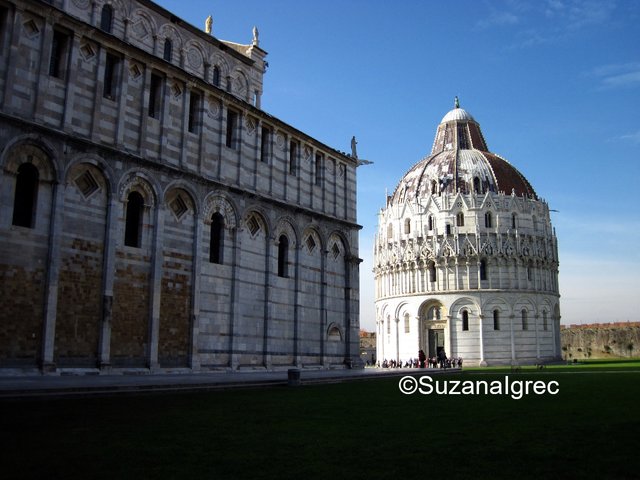
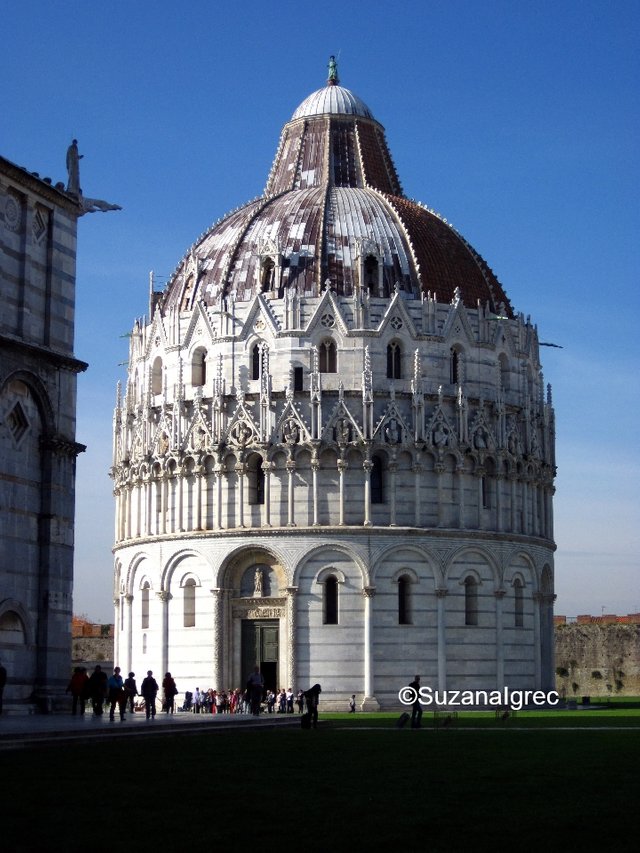

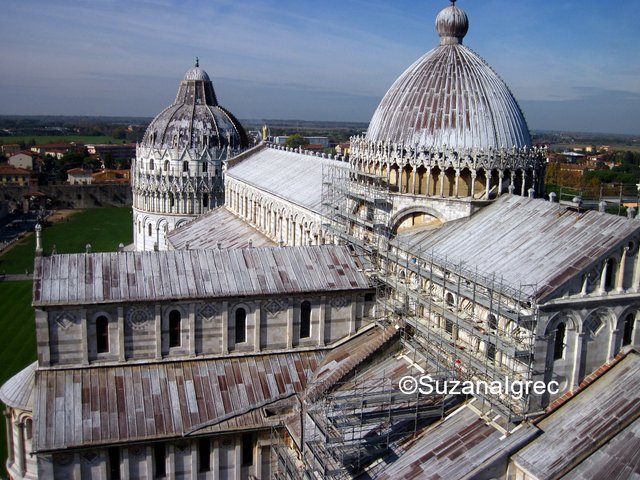
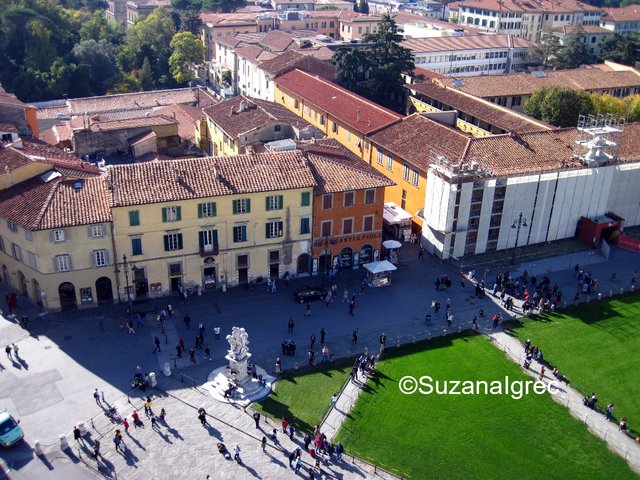
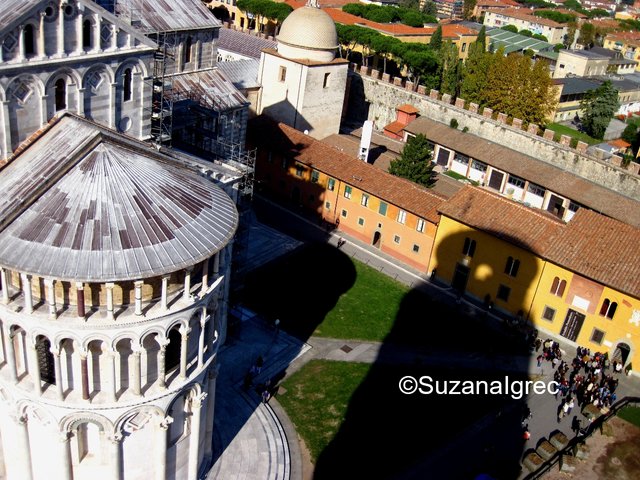

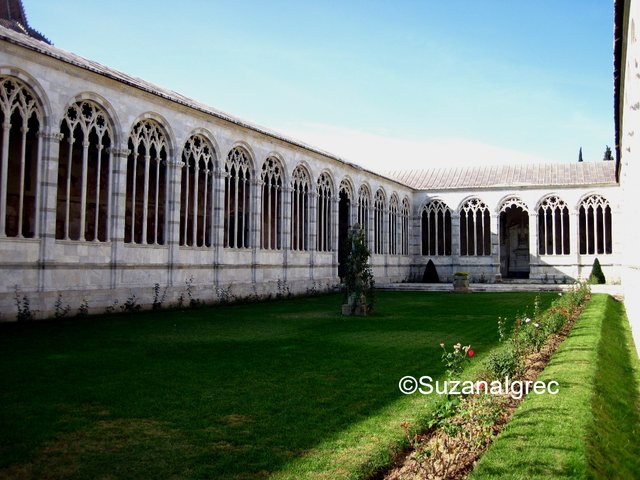
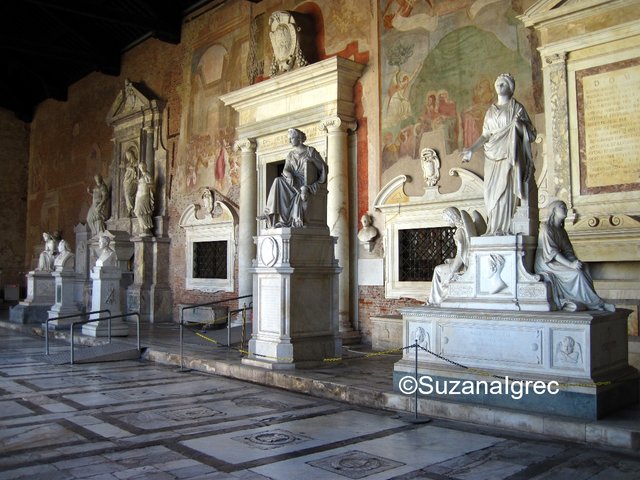
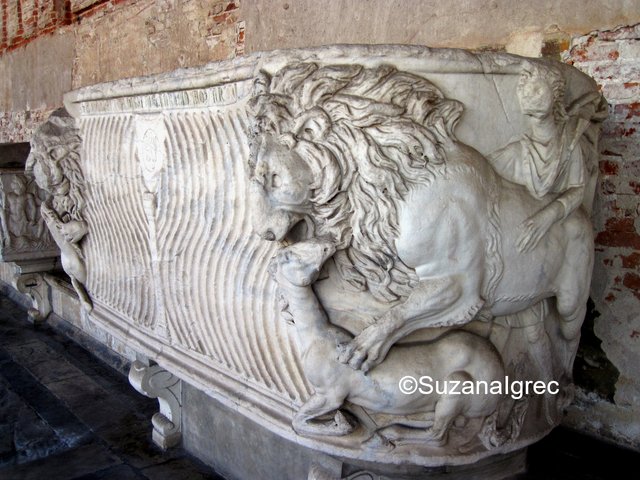
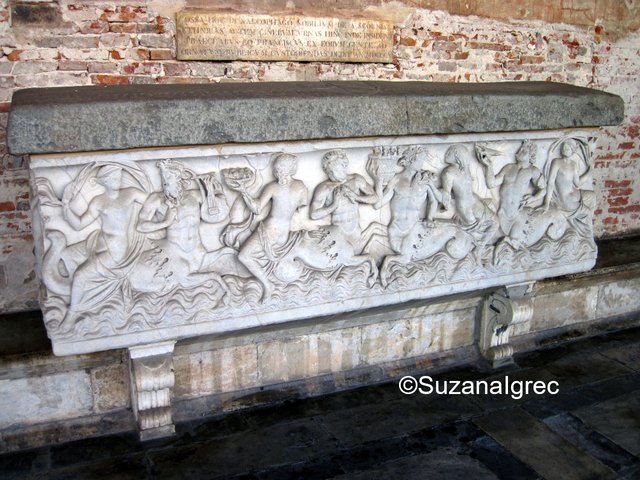
Congratulations @suzanaigrec! You received a personal award!
You can view your badges on your Steem Board and compare to others on the Steem Ranking
Do not miss the last post from @steemitboard:
Vote for @Steemitboard as a witness to get one more award and increased upvotes!
Downvoting a post can decrease pending rewards and make it less visible. Common reasons:
Submit